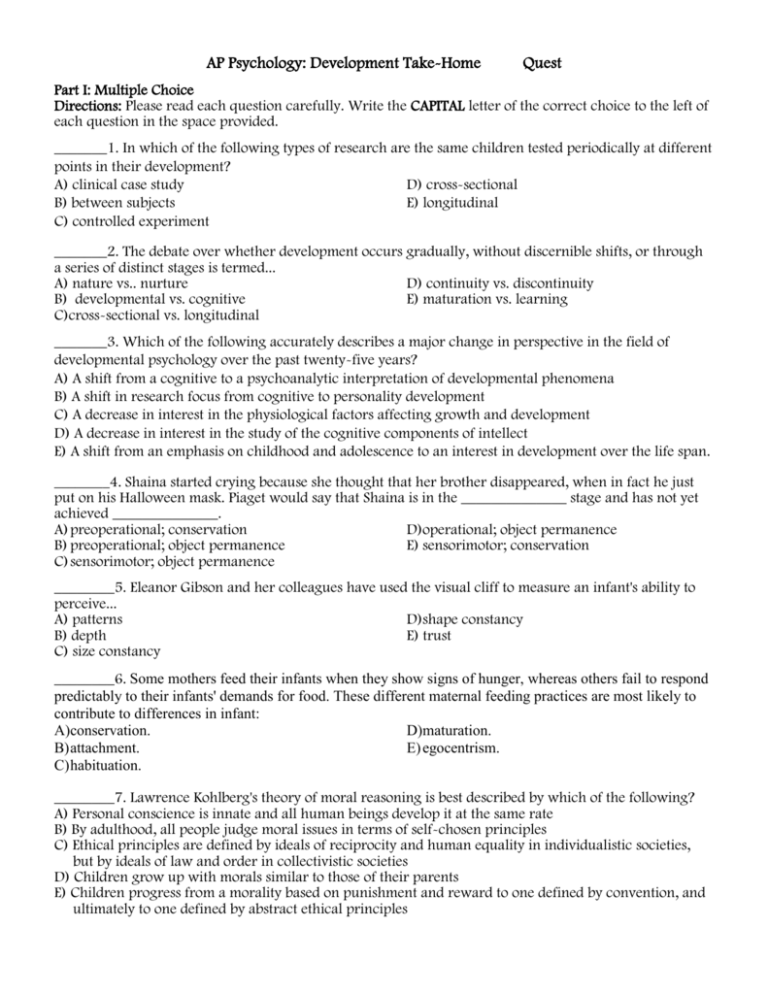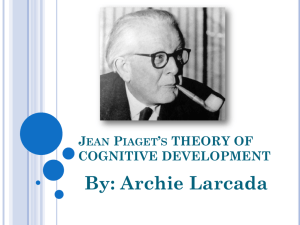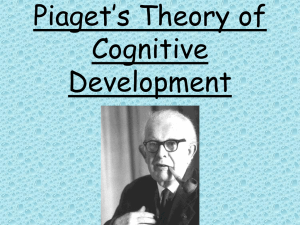File - Ms. G's Classroom
advertisement

AP Psychology: Development Take-Home Quest Part I: Multiple Choice Directions: Please read each question carefully. Write the CAPITAL letter of the correct choice to the left of each question in the space provided. _______1. In which of the following types of research are the same children tested periodically at different points in their development? A) clinical case study D) cross-sectional B) between subjects E) longitudinal C) controlled experiment _______2. The debate over whether development occurs gradually, without discernible shifts, or through a series of distinct stages is termed... A) nature vs.. nurture D) continuity vs. discontinuity B) developmental vs. cognitive E) maturation vs. learning C)cross-sectional vs. longitudinal _______3. Which of the following accurately describes a major change in perspective in the field of developmental psychology over the past twenty-five years? A) A shift from a cognitive to a psychoanalytic interpretation of developmental phenomena B) A shift in research focus from cognitive to personality development C) A decrease in interest in the physiological factors affecting growth and development D) A decrease in interest in the study of the cognitive components of intellect E) A shift from an emphasis on childhood and adolescence to an interest in development over the life span. ________4. Shaina started crying because she thought that her brother disappeared, when in fact he just put on his Halloween mask. Piaget would say that Shaina is in the ______________ stage and has not yet achieved ______________. A) preoperational; conservation D)operational; object permanence B) preoperational; object permanence E) sensorimotor; conservation C) sensorimotor; object permanence ________5. Eleanor Gibson and her colleagues have used the visual cliff to measure an infant's ability to perceive... A) patterns D)shape constancy B) depth E) trust C) size constancy ________6. Some mothers feed their infants when they show signs of hunger, whereas others fail to respond predictably to their infants' demands for food. These different maternal feeding practices are most likely to contribute to differences in infant: A)conservation. D)maturation. B) attachment. E) egocentrism. C) habituation. ________7. Lawrence Kohlberg's theory of moral reasoning is best described by which of the following? A) Personal conscience is innate and all human beings develop it at the same rate B) By adulthood, all people judge moral issues in terms of self-chosen principles C) Ethical principles are defined by ideals of reciprocity and human equality in individualistic societies, but by ideals of law and order in collectivistic societies D) Children grow up with morals similar to those of their parents E) Children progress from a morality based on punishment and reward to one defined by convention, and ultimately to one defined by abstract ethical principles ________8. According to Jean Piaget, what is the earliest stage at which a child is capable of using simple logic to think about objects and events? A) sensorimotor D) concrete operational B) preoperational E) formal operations C) symbolic _______9. In an experiment, children see a doll named Sally leave her ball in a red cupboard and go away. They then observe another doll, Anne, move the ball to a different location. In asking children where Sally will look for the ball upon her return, the investigators are testing the children's: A) stranger anxiety. D)moral reasoning. B) accommodation. E) habituation. C) theory of mind. _______10. A critical period is a phase during which: A) children frequently disobey and resist their parents. B) the child begins to understand the abstract. C) parents frequently show impatience with a child's slowness in becoming toilet trained. D) certain events have a particularly strong impact on development. E. children become able to think hypothetically and reason abstractly. _______11. In a famous series of experiments conducted by Harry Harlow, infant monkeys were separated from their mothers at birth. The infants were then given two surrogate mothers (a terry-cloth "mother" and a wire "mother"), each of which alternately had a nursing bottle that provided food to the infants. The experimental results showed that in frightening situations the infant monkeys... A) were more likely to become aggressive toward the wire mother than toward the terry-cloth mother B) failed to seek out either of the mothers because of their lack of experience in seeking contact comfort C) preferred the wire mother, even when the terry-cloth mother had the nursing bottle D) preferred the terry-cloth mother, even when the wire mother had the nursing bottle E) would run and cling to whichever mother had the nursing bottle _______12. Mrs. Potter asks Malik if he wants his sandwich in one piece, or cut into two pieces. Malik asks her to keep it in one piece, because he isn't hungry enough to eat two pieces. Malik's answer suggests that he A) does not yet understand conservation B) is in between the stages of assimilation and conservation C) cannot accommodate changes in the shape of the sandwich D) has not yet mastered object permanence E) cannot assimilate changes in the shape of the sandwich ______13. Alzheimer's disease involves a deterioration of neurons that produce: A) epinephrine. D)dopamine. B) adrenaline. E) acetylcholine C) estrogen. _______14. Three-month-old Andrew was obviously startled by the first ring of the telephone, but with each subsequent ring he seemed to become less reactive. This best illustrates the process of: A) imprinting. D)attachment. B) habituation. E) accommodation. C) conservation. _______15. Compared to authoritarian parents, authoritative parents are likely to be: A) more conservative. D)less educated. B) less involved. E) more responsive. C) less trusting. _______16. According to Erikson, adolescence is to identity as late adulthood is to: A) autonomy. D)generativity. B) trust. E) integrity. C) intimacy. _______17. Which of the following is an example of a secondary sex characteristic? A) male facial hair D)abstract thought. B) female height E) female ovaries C) the male grip _______18. The relative lack of neural interconnections in the association areas at the time of birth is most likely to contribute to: A) stranger anxiety. D)insecure attachment. B) the rooting reflex. E) imprinting. C) infantile amnesia. _______19. Nutrients and oxygen are transferred from a mother to a fetus through the: A) neural networks. D)teratogens. B) placenta. E) association areas. C) embryo. _______20. Lorenz found that after a gosling is born it tends to follow the first large moving object it sees. This is an example of A) reaction formation. B) a reflex. C) a developmental sequence of conditioning. D) an instinctive behavior released by environmental cues. E) observational learning. Part II: Vocabulary Directions: Please write the term that best corresponds to each definition _____________________1. Agents, such as chemicals and viruses that can reach the embryo or fetus during prenatal development and cause harm. _____________________2. Adopting one’s schemas to incorporate new information. _____________________3. Decreased responsiveness with repeated stimulation. _____________________4. The inability of the preoperational child to take another’s point of view. (Piaget). _____________________5. The principle that properties such as mass, volume, and number remain the same despite changes in the forms of objects. _____________________6. The stages of cognitive development during which individuals begin to think logically about abstract concepts (Piaget). _____________________7. A disorder that appears in childhood and is marked by deficient communication, social interaction, and understanding others’ states of mind. _____________________8. The process by which certain animals form attachments during a critical period early in life. _____________________9. A parenting style where the parents are both demanding and responsive. _____________________10. According to Erikson, a sense that the world is predictable and trustworthy. _____________________11. Research in which the same participants are restudied and retested over a long period of time. _____________________12. The cessation of the ability to reproduce accompanied by a decrease in estrogen. _____________________13. Process by which we incorporate new information into our existing schemas. _____________________14. The transition from childhood to adulthood, extending from puberty to a state of independence. _____________________15. The stage of moral development in which individual try to live up to the expectations of others and later, to maintain and abide by law and order. _____________________16. The theory that emphasizes the role of the environment and gradual growth in cognitive development. _____________________17. After an absence of the caregiver, the baby is angry and rejects the caregiver by ignoring and avoidance or by behaving inconsistently. _____________________18. An infant’s natural disposition to show a particular mood at a particular Intensity for a specific period. _____________________19. A degenerative disease in which brain neurons progressively die, causing a loss of memory, reasoning, emotion, body functions, and finally death. _____________________20. The issue that is the primary focus during psychosocial development where children, if successful, learn to become independent self-starters (Erikson) _____________________21. The crisis during psychosocial development where individuals, if not successful in their resolution of these issues, may feel a lack of purpose (Erikson). _____________________22. The culturally preferred timing of events. _____________________23. The physical, cognitive, and social changes that occur throughout the lifespan. _____________________24. An individual’s ability to reason speedily and abstractly. _____________________25. A study in which people of different ages are compared to one another. ____________________26. In individual’s accumulated knowledge and verbal skills; tends to peak later in life. ____________________27. According to Erikson, the crisis or issue that adolescents face in their psychosocial development. ____________________28. The researcher who suggested that women are not morally inferior, just morally different based on their ethic of care (the caring thing to do). ___________________29. The creation of a close, emotional relationship between mother and baby shortly after birth. ____________________30. The period of cognitive development where a child uses trial and error to figure things out and answers questions intuitively rather than logically (Piaget).






